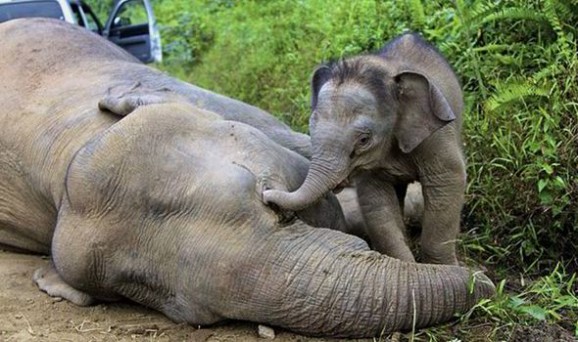Elephants Can’t Deal With Death
This article is more than 2 years old

I’ll start by saying that this is the saddest post I’ve done for a while—probably the saddest since the one on climate change. So if you’re one of those folks who reads GFR for its pop culture news and sci-fi reviews, you may want to skip this one. But if you’re here for the science, well, then we’ll do this together.
I’m sure it’s not news to anyone that elephant poaching is horrible, and if you’ve been following the news recently you know that it’s gotten completely out of control. Estimates indicate that during 2012 in Africa, 32,000 elephants were killed. That’s 96 elephants each day or one elephant every 15 minutes. In Kenya, the elephant population has fallen from 167,000 to 35,000 in the last 30 years; the African forest elephant population has plummeted by 72% in the last decade. Elephant poaching is among the world’s most profitable criminal activities, raking in over $6 billion each year. And even though it’s illegal, and even though selling ivory internationally has been banned since 1989, laws don’t seem to work as deterrents—people are after elephant tusks more vehemently than ever. There was a 50% increase in the seizure of illegal ivory in 2012. Recently, poachers used cyanide to kill 300 elephants in a Zimbabwe nature reserve. Yeah, I’m ready to cry. But it gets worse.

Apart from extinction, how could it possibly be worse? The answer would be obvious to someone who anthropomorphizes animals, but in this case, it seems the attribution of human feelings and awareness isn’t fallacious—elephants are traumatized by the slaughter of their families, and in fact, the killings cause serious social problems for the elephants. A study lead by Colorado State University behavioral ecologist Graeme Shannon indicates that the actions of humans can impact the social skills of elephants for decades, which carries negative consequences for their complex societies. It’s the first study to confirm such a conclusion, and it’s quite possible that other large-brained, social mammals such as chimpanzees, dolphins, and whales might suffer similarly.
For the study, scientists used elephants whose herds had been culled—that’s a systemic management tool that involves rounding up older elephants and having them put down professionally to avoid overpopulation destroying the habitat. During a cull, elephants ages 4-10 are spared, and then usually sent off to other parks or reserves where the elephant population needs to be increased. Culling was using from the 1960s to the 1990s.

Some of the surviving elephants were relocated to Pilanesberg National Park in South Africa, so Shannon decided to conduct a large part of the study there. Scientists have already determined that elephants can suffer from PTSD, and theorize that the surviving elephants’ behavior was drastically affected by the culling. Orphaned male elephants have been found to be unusually aggressive, even killing a slew of rhinoceroses. Scientists theorize that this may be due to PTSD, hormones, and/or a lack of older role models to teach the younger male elephants how to behave. In short, the scientists in the study believe there are “deficits in the social decisions that they make.”
The scientists compared reactions from elephant families that had been culled to elephant families that hadn’t. They mimicked calls from unfamiliar elephants, broadcasting them to the groups for 10-20 seconds. Then they observed the elephants’ reactions to the potential threat. In the unculled herd, the elephants froze, listened, and sniffed. Then they got into a group and started looking for the intruder, sometimes running past the scientists. Their responses were coordinated and appropriate.
But the Pilanesberg elephants were a different story. They didn’t have a coordinated response. Some stayed relax, as though the call didn’t indicate a potential threat. But in another instance, in response to the call of a known elephant, the herd took off and didn’t stop for a kilometer. The scientists believe that the elephants failed to recognize the calls, probably because the elephants never knew their families and never learned how to appropriately respond. Given how tight elephant families are and how much knowledge they pass on to later generations, the scientists worry that these elephants will actually pass on their lack of social cues and their poor responses. And if this is the response to culling, which at the time was a controlled technique, we can only imagine how elephants whose families have been slaughtered and poached might be reacting.

Eventually, the bad decision making that results from this kind of lapse could negatively impact elephants’ reproduction—something they definitely don’t need. Previous studies show that the elephant families that have the most calves are guided by a large number of old and experienced elephants.
Well…there you have it—a nice depressing post to start the week. Let’s all check in with the panda cam so we can feel better.












